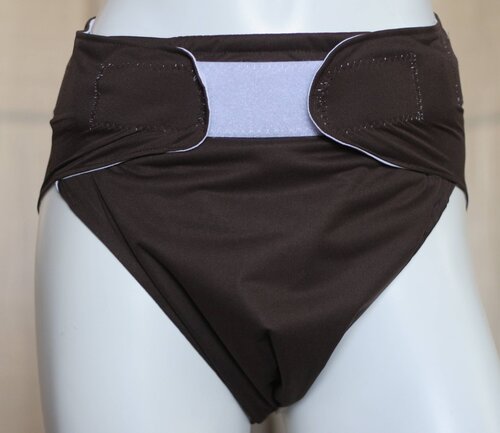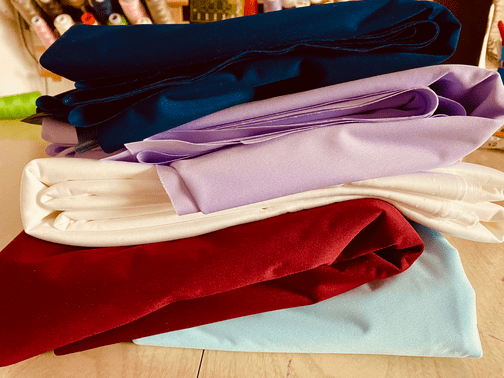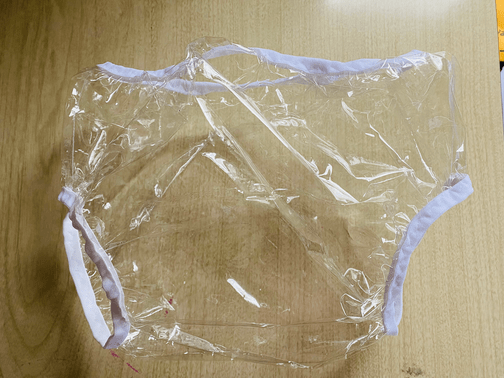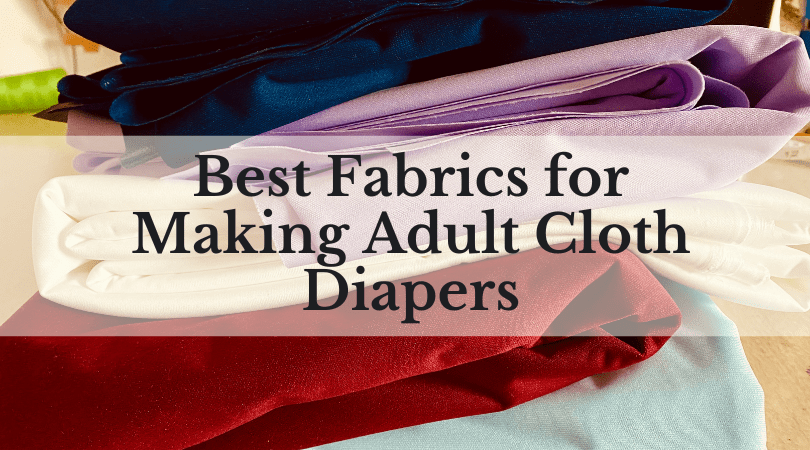This topic is both incredibly simple to answer and ridiculously complicated. The simple answer is PUL. After all, you can buy it anywhere in any color and in a variety of prints. The ridiculously complicated part comes in if you’re interested in alternatives to PUL…like, oh I don’t know…plastic pants? Nylon? These sorts of diaper covers are ubiquitous in the adult cloth diapering world, but where the hell do you get the fabric to make your own!?
To answer these questions, I ventured beyond enemy lines (just kidding) and emailed a ton fabric and cloth incontinence product companies. All with mixed results. At the end of the day, I found that fabric companies just aren’t familiar with diaper cover fabrics outside of PUL.
Commercially Available Diaper Covers
While I emailed a bunch of fabric companies, I also emailed 10 cloth incontinence product companies. I thought that maybe if I could figure out what material is used in commercial products, I could somehow translate that into fabric you could buy by the yard.
Unfortunately, many companies that sell plastic/nylon/vinyl pants either have extremely unknowledgeable customer service or don’t bother to email me back. Am I competition just because I want to teach people how to make their own!? Who knows?
I was also asking questions about their most popular products and how to care for plastic pants since I plan to write further posts on both of these topics. Killing two birds with one stone and all that.
Anyway.
What I learned is basically that many of the commercially available diaper covers are made from vinyl coated fabrics. The exception to this are the ones that are, well, made from vinyl….so not helpful. I know. ![]() I STILL haven’t figured out what’s the best vinyl to use when making diaper covers.
I STILL haven’t figured out what’s the best vinyl to use when making diaper covers.
Bleh.
If you want to know what type of diaper cover you should use, check out my post: Should You Use Vinyl, Plastic, Nylon, PUL, Wool, or Rubber Diaper Covers.
But before we get into that and other fabrics available for adult diaper covers, let’s go over a couple rules of thumb when it comes to choosing fabric for making cloth diaper covers.

How to make a cloth diaper cover
Obviously, if you want a diaper cover, you want a waterproof barrier between your body and everything else. When choosing fabrics, always check the suggested uses and the weight to make sure that the fabric could work for a cover.
The last thing you want to do is pick a fabric like a 840 denier coated ballistic nylon fabric. I mean, this stuff was originally used to make flak jackets for WWII pilots and whose use has been replaced by kevlar. Waterproof and heavy duty, sure, but that weight of fabric does NOT play nicely with elastic.
Unfortunately, outside of PUL, there isn’t a clear answer to what fabric to use. Though technically, you could use just about any waterproof fabric.
While different fabrics have different textures and weight, their efficacy really boils down to 2 things. Fit and absorption. Let’s take a look.
FIT
If you’re making your own diaper cover, chances are it’s because you want a specific fit or style of cover. After all, plastic pants are dirt cheap (though durability is up for question) and the ones that aren’t dirt cheap made in China are still quite affordable (and more durable). Plus, most plastic diaper covers get EXCELLENT reviews.
Anyway, let’s go back to fit. Regardless of the why and what of your diaper cover making endeavors, fit plays an enormous role in whether or not your homemade diaper cover will be effective at keeping the wetness in and everything out dry.
Specifically, the fit around the legs and waist. The key is to make it tight, but not so tight that it will leave marks on your legs and waist. It also needs to completely cover any part of the diaper underneath, which leads us to the next rule.
ABSORPTION
A diaper cover is only as effective as the amount of absorption inside. Whether you’re using your cover over a disposable product for extra protection or over an all cotton diaper, if there is not enough absorbing material on the inside, your cover will leak.
This also goes for plastic pants, though they do tend to hold in the moisture a little better. Still, there’s no way around the fact that if you have loose liquid rolling around inside your cover, it’s only a matter of time before it figures out how to migrate to the outside.
Gauge vs. Mil vs. Denier
In the fabric world, there are lots of different ways to measure the thickness of fabric. In all cases, the larger the number, the thicker the fabric or laminated layer. Let’s take a quick look:
Gauge
1 gauge = .001 inch
Mostly used in measuring fabrics like pvc/vinyl.

Mil
1 mil – .000001 inch
This is used for fabrics that are laminated with waterproof materials like pvc, polyurethane, urethane, etc.
Denier
1 denier = 1 gram/9000 meters
This unit of density is compared against the thickness of a strand of silk, which is 1 denier. It is now mostly used for synthetic fabrics, like nylon or polyester.
For flexibility and ease of wearing, you want to stick to the smaller end of these units of measurement, especially in gauge and denier.

1. PUL
Ah PUL, so pretty, so sewable, so breathable. The breathable part is particularly awesome if you deal with diaper rash, but PUL is not as watertight as PVC plastic or vinyl or nylon.
PUL stands for polyurethane laminate and is a cleaner, greener way of coating fabric than using PVC. Most commonly, you’ll find PUL laminated to a polyester knit fabric.
Unfortunately, this has the downside of offering moisture a place to migrate too. What this means, is that if moisture leaks a little at the legs, it can migrate across the polyester knit fabric, making the outside of the cover feel wet. However, gussets do tend to help mitigate this as they offer an extra barrier against the moisture.
Wazoodle offers a wide range of PUL laminated fabrics from fleece to nylon to the standard polyester.
Where to Buy
The biggest pro to PUL is its availability. A google search easily returns a bunch of accessible shopping options from Amazon to small businesses. Here are my some that offer a variety of options:
- Nature’s Fabrics (my favorite)
- Wazoodle
- Happy Baby
- ClothDiaper.com
2. Nylon
Nylon is a synthetic fabric that is frequently used for commercially produced diaper covers. Babykins has a nylon taffeta cover that several people have told me they love. The trick is to find this fabric for sale by the yard! Several places do sell a pvc backed nylon taffeta that could work, like Discovery Fabrics.
I’ve had several fabric places recommend coated ripstop nylon. However, when the description says it has a “distinctive paper-bag rustle when two pieces rub together” I’m inclined to think that perhaps that wouldn’t be the best fabric choice for a diaper cover….
Honestly, any pvc backed fabric would probably work as long as it’s not too stiff (or noisy!). Comfort is key, after all. Just like PUL is a knit fabric laminated by polyurethane, the same concept could be applied to PVC backed fabrics.
3. Vinyl (PVC)
A lot of classic plastic pants are made from PVC vinyl in the range of 4 – 8 gauge. Honestly, I’ve had a hard time figuring out exactly what fabric is used commercially.
I picked up some 4 gauge clear vinyl from Online Fabric Store and it actually made a decent looking cover. The problem is, the vinyl is noisy! When I laid out the fabric to cut it, it smelled, looked, and sounded like a shower curtain 😆.

The biggest downside to pvc vinyl is that it can be challenging to sew with. You need to be extra careful of not using pins to hold it together. I’ve found that using fold over elastic is a super easy way to make a cover out of this stuff.
4. 100% PEVA
This stuff is what Gerber uses to make their baby pull on plastic pants. Basically, PEVA is a nonchlorinated vinyl and in the case of whatever fabric Gerber uses, is also free from phthlalates. Remember, baby stuff has to meet strict regulations, which is why you don’t see pvc diaper covers for babies.
The downside is that this stuff is impossible to buy by the yard. Luckily, you could just buy a 100% PEVA shower curtain and turn it into a diaper cover! Remember, nothing says you can’t use any type of waterproof fabric for an adult diaper cover. After all, the only issue is washing and how it fits your body.
5. Wool
Wool is hands down the most expensive fabric for cloth diaper covers, but gets ALL the points for breathability and eco-friendliness. The biggest downside lies in the fact that if you want full on waterproof qualities, you have to lanolize it. Though this is a fairly simple process, it still requires extra work and an extra learning curve.
Etsy is the only place I’ve seen where you can buy wool diaper covers. If you struggle particularly hard with rash and skin irritation that even PUL covers and changing frequently don’t manage, wool may be a good choice to try. If you make your own, you can mitigate some of the cost associated with using wool.
Alecia
Latest posts by Alecia (see all)
- Best Adult Diaper Covers - March 7, 2024
- Best Fabrics for Making Adult Diaper Covers - February 16, 2024
- How to Use the Zigzag Stitch - May 4, 2023


